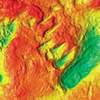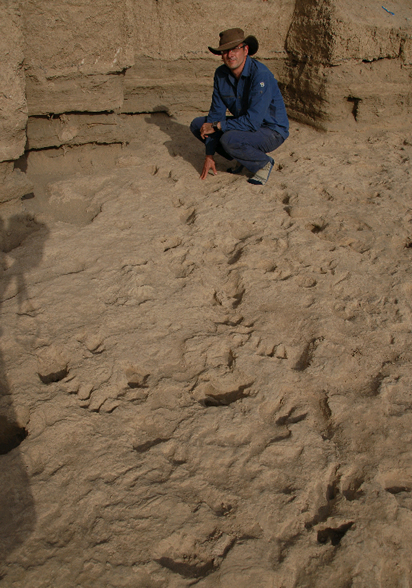
 |
BU expert leads international research into the world?s second oldest footprints |
BU expert leads international research into the world’s second oldest footprints.
BU Professor Matthew Bennett is the lead author of a landmark paper published in the acclaimed journal Science this week which reveals new evidence of early human development.
The paper reveals new evidence that one of our human ancestors, Homo erectus, had essentially modern foot anatomy and function.
Foot bones are rarely preserved because they are small, encased in flesh, and easily consumed by carnivores. Consequently, our knowledge of foot anatomy and function in early hominins is poor. Fossil footprints provide an alternative line of evidence and additionally contribute direct data on walking gait, but footprints are rare within the geological record. In this week’s issue of Science, Professor Matthew Bennett of Bournemouth University and an international team of colleagues report on a recently discovered set of hominin and animal footprints which date from 1.51-1.53 million years ago at Ileret, Northern Kenya.
“Considerable debate continues over when and in what context a modern human-like form of bipedalism evolved because of the fragmentary record and disagreements over the functional interpretations of existing fossils and footprints,” says Dr. A.K. Behrensmeyer of the Smithsonian Institution. Professor Bennett states that,”our findings from Ileret show that by 1.5 million years ago, hominins had evolved an essentially modern human foot function and a style of bipedal locomotion that we would recognize today.”
In a project led jointly by Professor John W.K. Harris (Rutgers University), and by the National Museums of Kenya, the research team excavated two distinct sedimentary layers in a single outcrop at Ileret to reveal footprints preserved in fine-grained mud. These surfaces have been dated precisely via interbedded volcanic ash layers and were digitally scanned by Professor Bennett to create three-dimensional digital elevation models of the prints, accurate to a fraction of a millimeter. The international team (from the UK, USA, South Africa, and Kenya) has shown that the prints were probably formed by the species Homo erectus. The unique structure of the modern foot is characterized by a fully adducted big toe, large and robust heel and tarsal sections, a pronounced medial longitudinal arch and short toes, all of which are evident in the footprints studied.
Professor Brian Richmond (George Washington University,) a leading postcranial paleo-anatomist said, “the discovery of hominin footprints is an incredibly rare event, and the new prints are the second oldest in the world after the Laetoli prints in Northern Tanzania, making this one of the most important discoveries in recent years with respect to research on the evolution of human gait.” By applying geometric morphometric statistics to biological landmarks placed on the footprint scans, Professor Bennett was able to determine that the shapes of these prints are significantly more like those formed by modern humans compared to the prints from Laetoli (dated to 3.75 million years and believe to have been formed by Australopithecus afarensis). This research establishes for the first time an objective methodology for the analysis and comparison of hominin footprints.
Based on the size of the prints and the stride pattern of these newly discovered footprints, Professor Bennett and his colleagues have determined that the species responsible would have been approximately 1.75 meters in height. “The size and stature estimates derived from the Ileret prints compare well with those of Homo erectus and are too large to have been formed by other hominin species living in this part of Africa in the early Pleistocene,” states Professor Richmond.
“These footprints together with evidence from the archaeological record support the hypothesis of a hominin with a larger home range and enhanced dietary quality, giving us an emerging picture of the paleobiology of early Homo erectus that suggests a shift in cultural and biological adaptations relative to earlier hominins,” Professor Harris concludes.
The process of laser scanning not only provides a unique method of analysis, but also allows for their preservation. The outcrop within which these prints are located is steadily eroding, thereby placing this valuable site at great risk. The digital scans are easily replicable and can be transformed into real-life casts available for museum display around the world. The National Museums of Kenya (NMK) has pioneered research in early hominin evolution in Northern Kenya over the last 40 years. Dr. Emma Mbua of NMK says “this is one of the most important discoveries of recent years, and the museum is doing everything possible to ensure the safety of this unique site, which it hopes to bring to audiences worldwide in the future.”

27/02/09